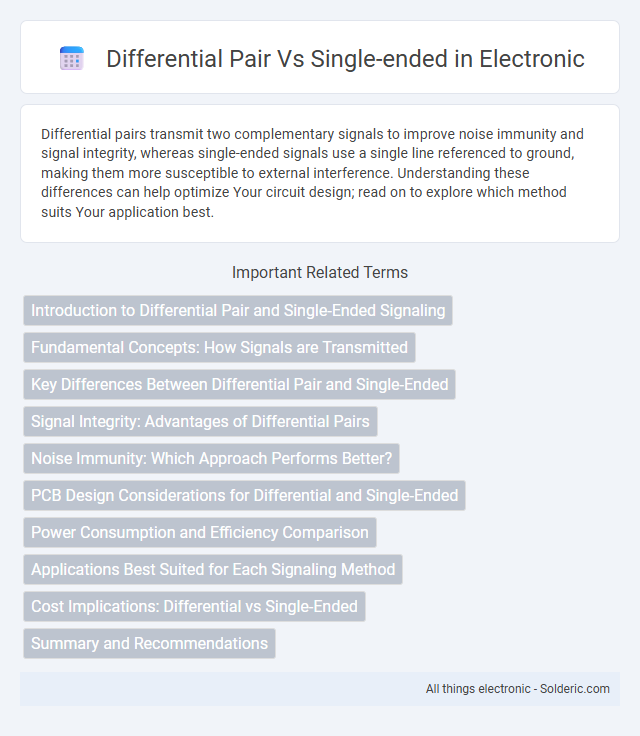Differential pairs transmit two complementary signals to improve noise immunity and signal integrity, whereas single-ended signals use a single line referenced to ground, making them more susceptible to external interference. Understanding these differences can help optimize Your circuit design; read on to explore which method suits Your application best.
Comparison Table
| Feature | Differential Pair | Single-Ended |
|---|---|---|
| Signal Transmission | Two complementary signals | One signal referenced to ground |
| Noise Immunity | High, rejects common-mode noise | Low, susceptible to noise |
| Signal Integrity | Improved, reduced EMI | Lower, more EMI radiation |
| Complexity | Higher, requires matched pairs | Lower, simpler routing |
| Cost | Higher due to more routing and components | Lower, fewer components needed |
| Common Applications | High-speed data transmission, USB, Ethernet | Audio signals, standard digital I/O |
| Impedance Control | Critical for performance | Less critical |
| Power Consumption | Moderate to high | Generally lower |
Introduction to Differential Pair and Single-Ended Signaling
Differential pair signaling transmits two complementary signals on separate conductors, enhancing noise immunity and reducing electromagnetic interference compared to single-ended signaling, which sends a signal referenced to a common ground. Your choice between differential and single-ended signaling impacts signal integrity, especially in high-speed or noise-sensitive applications. Differential pairs provide improved performance in data communication and measurement systems by minimizing common-mode noise and ensuring accurate signal transmission.
Fundamental Concepts: How Signals are Transmitted
Differential pairs transmit signals through two complementary conductors carrying equal and opposite voltages, enhancing noise immunity and signal integrity by allowing the receiver to detect the difference between the two signals. Single-ended transmission uses one conductor and a common ground reference, making it more susceptible to noise and electromagnetic interference. The differential signaling method reduces electromagnetic emissions and improves performance in high-speed or noisy environments compared to single-ended signaling.
Key Differences Between Differential Pair and Single-Ended
Differential pairs transmit signals using two complementary conductors, providing superior noise immunity and signal integrity compared to single-ended transmission, which uses one conductor referenced to ground. Key differences include reduced electromagnetic interference and crosstalk in differential pairs due to balanced signaling, while single-ended signals are more susceptible to noise and signal degradation over long distances. Your choice affects system performance, especially in high-speed or sensitive analog applications where noise rejection is critical.
Signal Integrity: Advantages of Differential Pairs
Differential pairs significantly enhance signal integrity by minimizing electromagnetic interference (EMI) and crosstalk through their balanced transmission, which cancels out common-mode noise. Their complementary signals provide higher noise immunity and improved signal-to-noise ratio (SNR) compared to single-ended lines. This results in cleaner data transmission with reduced bit error rates, making differential pairs ideal for high-speed communication interfaces like USB, PCIe, and HDMI.
Noise Immunity: Which Approach Performs Better?
Differential pair signaling offers superior noise immunity compared to single-ended signals by transmitting two complementary voltages, allowing common-mode noise to be effectively canceled at the receiver. Single-ended signals, referenced to a common ground, are more susceptible to electromagnetic interference and ground noise, leading to higher error rates. This makes differential pairs the preferred choice in high-speed and noisy environments for maintaining signal integrity.
PCB Design Considerations for Differential and Single-Ended
PCB design for differential pairs requires precise impedance matching and tightly controlled trace spacing to minimize noise and crosstalk, ensuring signal integrity in high-speed applications. Single-ended traces demand careful attention to impedance control and ground return paths to reduce electromagnetic interference and signal degradation. Differential pairs offer superior noise immunity and reduced electromagnetic emissions compared to single-ended signals, making them ideal for modern high-frequency digital and analog circuits.
Power Consumption and Efficiency Comparison
Differential pair signaling consumes more power than single-ended signaling due to the need to drive two complementary signals simultaneously, increasing overall current draw. However, the improved noise immunity and signal integrity of differential pairs often yield higher efficiency in high-speed or long-distance transmission by reducing error-related retransmissions. Single-ended signals typically use less power but may require additional error correction, which can offset initial energy savings in complex communication systems.
Applications Best Suited for Each Signaling Method
Differential pair signaling is best suited for high-speed data transmission, noise-sensitive environments, and applications requiring signal integrity over long distances, such as Ethernet, USB, and HDMI interfaces. Single-ended signaling is commonly used in low-speed, short-distance, cost-sensitive applications like audio equipment, simple sensor inputs, and legacy communication protocols. Your choice between differential pair and single-ended should consider noise immunity, signal quality, and the specific requirements of the electronic system.
Cost Implications: Differential vs Single-Ended
Differential pair signaling typically incurs higher cost due to the need for matched pairs of conductors and more complex PCB routing, increasing material and manufacturing expenses. Single-ended signaling uses fewer traces and simpler layout, resulting in lower overall production costs for your project. Choosing between them depends on balancing budget constraints with performance requirements such as noise immunity and signal integrity.
Summary and Recommendations
Differential pairs offer superior noise immunity and signal integrity compared to single-ended signals, making them ideal for high-speed and long-distance communication. Single-ended signals are simpler and cost-effective but are more prone to electromagnetic interference and signal degradation. For your designs requiring reliability and minimal noise, especially in complex environments, differential pairs are the recommended choice, while single-ended remains suitable for low-speed or short-distance applications.
differential pair vs single-ended Infographic

 solderic.com
solderic.com